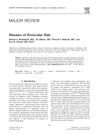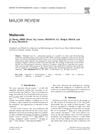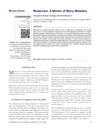TLDR Mitochondriopathy may cause eyelash loss.
The document discussed a case of madarosis, or eyelash loss, in a 79-year-old woman with mitochondriopathy (MCP), a condition not previously linked to madarosis. The patient had a history of various health issues, including cataracts, carcinomas, osteoporosis, and diabetes, but none were found to be the cause of her madarosis. The study suggested that MCP could be responsible for madarosis, supported by previous reports indicating that MCP can manifest in skin and hair abnormalities. In a study of 140 children with MCP, 10% showed hair or skin issues, and research on mice with mtDNA mutations linked MCP to hair loss and other aging symptoms. The findings proposed that MCP should be considered a potential cause of madarosis, especially when other causes are excluded.
 24 citations
,
January 2000 in “Dermatology”
24 citations
,
January 2000 in “Dermatology” Gene linked to common hair loss found, may lead to new treatments.
 7 citations
,
July 2011 in “Survey of Ophthalmology”
7 citations
,
July 2011 in “Survey of Ophthalmology” The document concludes that periocular hair disorders have various causes and treatments, and proper evaluation by specialists is important for management and prognosis.
 33 citations
,
November 2006 in “Survey of Ophthalmology”
33 citations
,
November 2006 in “Survey of Ophthalmology” Madarosis is the loss of eyelashes and eyebrows due to various health issues and requires thorough examination to diagnose and treat the underlying cause.
 36 citations
,
January 2012 in “International Journal of Trichology”
36 citations
,
January 2012 in “International Journal of Trichology” Losing eyelashes or eyebrows can be a sign of many different health problems and needs a careful approach to treat effectively.
26 citations
,
July 2005 in “Optometry and vision science” Botulinum A toxin injections may cause hair loss on the face and loss of eyelashes.
11 citations
,
August 2017 in “Supportive care in cancer” Madarosis (eyebrow and eyelash loss) significantly affects quality of life for breast cancer patients on taxane-based chemotherapy.



